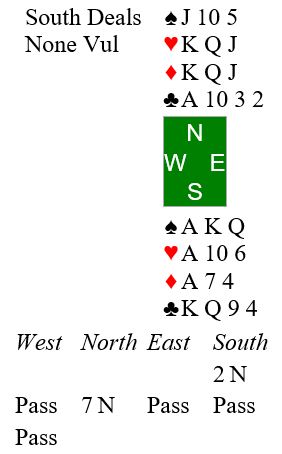What’s known as “counting the hand” in bridge might better be called visualization. Experts don’t actually count. They visualize possible ways each suit originally broke in the unseen hands, and they confirm or adjust that vision as more is learned from the play. For example, say you are declarer in a spade contract with silent opponents. You hold eight spades between you and dummy. You tentatively visualize opponents’ original spade holding as breaking either 3-2 or 2-3 (a 68 percent chance). But you realize that the less friendly breaks (4-1 or 1-4 or 5-0 or 0-5) are also possible (32 percent chance).
You start to draw trumps and find that right hand opponent shows out on the second round. Don’t grimace about the 4-1 break. All the other pairs sitting your way are getting the same unfriendly break. Focus instead on adjusting your vision of the unseen hands: You now know that left hand opponent started with four spades, and you know precisely which spades those are. Also, you recall that right hand opponent was silent during the auction even though she held a singleton spade. Adjust your plan of play based on your new, more accurate vision.
To give you a little visualization exercise “here is a rather extreme, but instructive, example” from Alfred Sheinwold’s Five Weeks to Winning Bridge*:
Opening lead is the 10 of diamonds. You have 12 sure tricks. The only possible worry is that clubs don’t break 3-2, and you lose a trick to the jack. You don’t have much of a vision of unseen hands to start with, other than they each contain 13 crummy cards. How are you going to go about visualizing the club suit to eliminate that one little worry?
To get a firm grip on opponents’ original holdings, take your tricks in the other three suits before you tackle clubs:
- You see West discard diamonds on the second and third spade, so now you know spades were split 1-6 between West and East.
- You play three rounds of hearts and both follow, so hearts were split either 4-3 or 3-4 between West and East.
- You see East discard a spade on the third round of diamonds, so diamonds were split 5-2 between West and East.
- Now you know that West started with one spade, 3 or 4 hearts, five diamonds, and East started with six spades, 4 or 3 hearts. two diamonds. Therefore East has at most two clubs. You play the king and queen of clubs, knowing that ace and 10 in dummy will take the last two trick.
* https://www.amazon.com/Weeks-Winning-Bridge-Alfred-Sheinwold/dp/4871876098

Steve
April 30, 2020 at 10:57 am
Cash your winners in ♠️,♥️, and ♦️To get a complete count of your opponents’ hands. You will find out if either opponent has 4 clubs and can finesse the jack through that hand after cashing the ♣️A(K) in case the J is bare. Steve